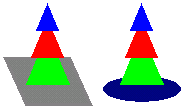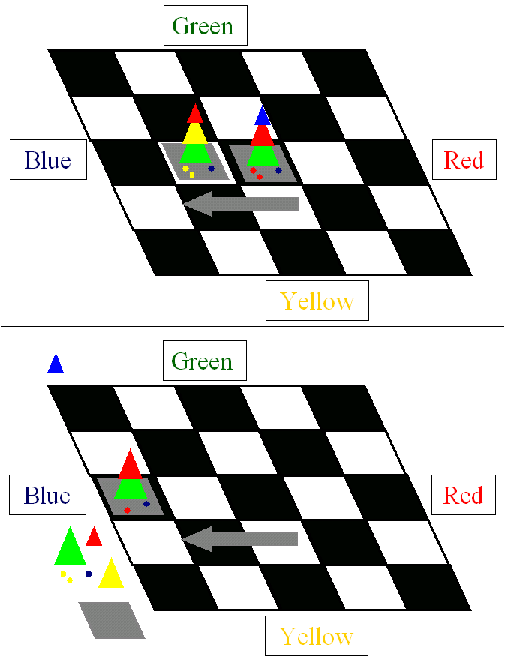Shove
An Icehouse Pyramids Game for Two to Four Players
By Brad Weier
First Draft - 06/25/02
I. Introduction and Set-up
1. Story
One of the most popular sports on Mars has to be the frequent fights between Martian BattleMids, remote controlled robots that range from the size of a man to the height of a building. Many years ago, the citizens of Mars realized the foolishness of war between people. Yet they also understood the joy of vicarious mayhem. Now, most disagreements end from a safe distance on a BattleMid field.
Like all great sports, Martian Mids battles spawned a popular home version, a board game called “Shove.” It features a simplified version of the combat seen on television, focused on controlling and pushing BattleMids around the field.
2. Materials Needed
To experience the joys of Shove, you need:
- One stash of red, blue, yellow, and green Icehouse Pyramids (http://www.looneylabs.com/)
- 12 glass beads or counters in a different color for each player. These are your Control Beads.
- A Chessboard
- One die of any size
You will also need some sort of Mid Stand to help you move the BattleMids and Control Beads around the board. Cardboard squares or Poker chips work well for this. If you are going to use cardboard as Mid stands, cut the cardboard into squares that are slightly smaller than the squares on the Chessboard.
Finally, label one edge of the Chessboard “red,” another “blue,” the third “yellow,” and the fourth “green.” It does not matter which side is which or what order you label them.
II. Assembly
 Play begins by setting up the Mids on the board. Place all of the pyramids within reach of every player. Roll a die to see who goes first. The first player takes a pyramid, places it on a Mid Stand, and sets the Mid on any square on the Chessboard. Moving clockwise around the table, each player takes one pyramid and either adds it to the top of an existing Mid or starts a new Mid on a new Mid Stand. Continue placing pieces until all of the pyramids are on the board.
Play begins by setting up the Mids on the board. Place all of the pyramids within reach of every player. Roll a die to see who goes first. The first player takes a pyramid, places it on a Mid Stand, and sets the Mid on any square on the Chessboard. Moving clockwise around the table, each player takes one pyramid and either adds it to the top of an existing Mid or starts a new Mid on a new Mid Stand. Continue placing pieces until all of the pyramids are on the board.
Mids can contain any number of pyramids of any size and color stacked on top of one another with the restriction that a pyramid can not be stacked upon another pyramid that is smaller than itself. Mids can not occupy a square already occupied by another Mid.
III. Bidding
Next, players take turns placing their Control Beads on Mid Stands. Beginning with the player to the left of the person who played the last pyramid on the board, place one bead on any Mid Stand on the board. Continue clockwise with each player placing one bead per turn. Continue placing beads until all players have exhausted their supply.
You may place more than one bead on a Mid Stand over multiple turns.
IV. Shoving
After all of the Mids and Control Beads are placed, it is finally time to shove each other off the board. Shoving begins with the player to the left of the person who played the last Control Bead. Play moves clockwise around the table. During a turn, you will select then move a Mid, possibly pushing others off of the board.
1. Select a Mid
Select one Mid where the number of your Control Beads on the Mid Stand is not outnumbered by any other one player’s beads on the Mid Stand. If you have an equal or greater number of Control Beads on a Mid compared to every other single player, you can select that Mid.
For example, if a Mid contains two blue beads, one green bead, and two red beads, the blue player may select this Mid on his turn. Blue is not exceeded by any one other color. It is equal to red and greater than blue.
If you can not select a Mid, either because your Control Beads are outnumbered on every Mid or because you have no Control Beads on the board, you skip your turn.
2. Move
Count the number of pyramids in the Mid you selected. Then note the color of the top pyramid in the Mid.
Move the selected Mid a number of squares equal to the number of pyramids it contains. Move the selected Mid towards the side of the board labeled with the color of its top pyramid. This move will be in a straight line towards the matching edge of the board. There are no diagonal moves in Shove.
A. Shove
If the selected Mid attempts to move into an occupied square, the second Mid is pushed in the same direction. If this pushed Mid attempts to move into an occupied square, the third Mid is pushed in the same direction. A Mid can push any number of other Mids.
B. Score
A selected Mid may not move off of the board. If it reaches the edge of the board with movement left, that movement is discarded.
Mids may, however, shove other Mids off the board. If the selected Mid’s movement pushes another Mid off the board, remove all of the Control Beads from the Mid and give the pyramids to the player that moved the selected Mid. That player will score these pyramids at the end of the game.
C. Check
Whenever a Mid stops at an edge without going off the board, check the color of its top pyramid. Whether the Mid moved to the edge or was pushed does not matter. If it matches the color of the edge it is on, remove the top pyramid and discard it from the game. Continue to remove pyramids until the top pyramid of the Mid does not match the edge it touches. In the case of a corner square, check both edge colors.
If you must remove the last pyramid in a Mid, then discard that pyramid, the Mid Stand, and any Control Beads that were on the Stand.
3. Remove a Control Bead
Finally, remove one of your Control Beads from the Pyramid you selected and moved.
V. Ending the Game
Continue taking turns moving clockwise around the table. The game ends when every Control Bead has been removed from the table.
Players then examine all of the pyramids they shoved off the board and add all of the pips. A pip is the small mark at the base of each pyramid. The small pyramids have one pip, the middle pyramids have two, and the large have three.
The player with the most pips wins.
VI. Example of Play
 This graphic illustrates one turn in a game of Shove. It is the player using red Control Beads turn. (Note that the Red Control Beads have nothing to do with the fact that there is a side named “Red.”)
This graphic illustrates one turn in a game of Shove. It is the player using red Control Beads turn. (Note that the Red Control Beads have nothing to do with the fact that there is a side named “Red.”)
The Red player selects the Mid with the small, blue pyramid on top. He has two Red Control Beads on it, which is not exceeded by any other color bead.
The top pyramid is blue, so the Mid must move to the left, towards the blue edge. The Mid contains three pyramids, so it will move three spaces.
The Red player moves the Mid two spaces to the left. It pushes the second Mid off the edge of the board. The third space is ignored, because a selected Mid can not move off the board.
The Red player takes all of the pyramids in the second Mid and keeps them for scoring. The yellow and blue Control Beads are no longer on the board and can not be used.
Because the selected pyramid is on the edge of the board, the Red player checks the edge. The top pyramid of the Mid is blue, and it is on the blue edge. Thus, the blue pyramid is removed from the game.
Finally, the Red player removes one red Control Stone from the Mid.
Note that the player with Blue Control Beads could select this Mid on her next turn. She would have to move it two spaces to the right.
VII. Designer Notes
My first game, Martian Mids, was, quite frankly, too complicated. It is fun, but it is difficult to learn without someone to teach you.
Two of my favorite mechanics from Martian Mids were the Shove attack and the Control attack. So I pulled those two ideas out and tried to write a simple game using just them.
This game is still in its alpha stage. We have played it once. Unfortunately I was the only one who liked it enough to continue working on it.
Some of the questions still under consideration are:
- Is 12 Control Beads too few or two many?
- Should a selected Mid be allowed to move off the board to collect points?
- Would adding diagonal moves improve the depth of the strategy?
- Is an 8 by 8 board too large?
- The game ends with a whimper instead of a bang as the last few moves are largely played to prevent anyone else from scoring. Is there any way to fix this?
- Is the game fun?
